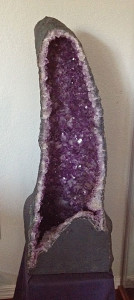Why are Geodes Hollow?
When I was showing a friend a beautiful Brazilian Amethyst geode he asked me why they were hollow. After stumbling around and mumbling about volcano’s, I had to admit that I really wasn’t sure. A bit embarrassing to say the least, so I decided to find out how they actually were formed.
The Brazilian geodes, sometimes referred to as Watermelon Geodes, are created through volcanic activity. Lava (liquid molten rock) flows from a volcanic outburst then cools and leaves hollow chambers or cavities together with gas bubbles that form within the flow. Intense heat mixed with the slow intrusion of mineral laden ground water means that crystals begin to grow. These gas bubbles cooled and rose to the surface where they were trapped and ended up becoming geodes. The interior crystals are influenced by iron and manganese which produces the beautiful purple color of Amethyst.
These geodes are incredibly difficult to mine. They are encased in very hard, dense basalt and each one has to be extracted using jackhammers and chisels and large ones can involve many workers and many days labour. The work is so difficult the miners will drill small holes in the geode to see if the quality of the Amethyst will justify the removal work involved.
The geodes are cleaned on their outer shell and the cut surface’s are then polished. Many geodes are repaired due to damage when being removed from the basalt. An incredible amount of work overall but it is worth all the trouble to have such beautiful pieces available for the world to enjoy.

